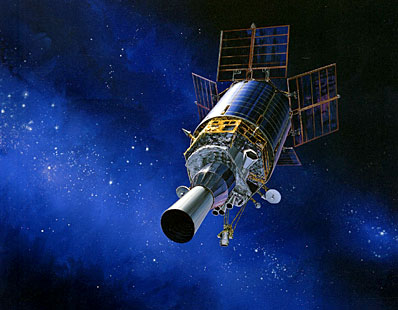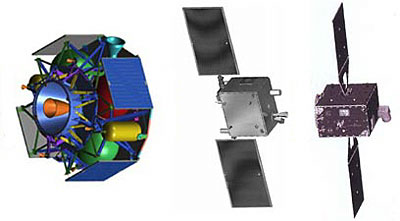Satellites Collide
Posted by Sam Churchill on February 11th, 2009
If our calculations prove to be correct, this will be the most frightening discovery of all time.
– When Worlds Collide
Two satellites have crashed 500 miles above Siberia in the first-ever in-orbit collision of two spacecrafts, reports SpaceFlightNow. Orbital junk has collided before, but this is the first time two fully intact satellites have smashed into each other, says the Washington Post.

 One of the crafts was a 1,235-lb Iridium satellite sent up in 1997. Iridium uses a constellation of 66 low orbit spacecraft for satellite phone service. Iridium confirmed today that one of its satellites was destroyed. The other was reportedly a 1 ton Russian spacecraft Cosmos 2251, a military store-dump satellite launched in June 1993.
One of the crafts was a 1,235-lb Iridium satellite sent up in 1997. Iridium uses a constellation of 66 low orbit spacecraft for satellite phone service. Iridium confirmed today that one of its satellites was destroyed. The other was reportedly a 1 ton Russian spacecraft Cosmos 2251, a military store-dump satellite launched in June 1993.
Air Force Brig. Gen. Michael Carey, deputy director of global operations with U.S. Strategic Command, the agency responsible for space surveillance, said initial radar tracking detected some 600 pieces of debris.
Nicholas Johnson, chief scientist of NASA’s Orbital Debris Program Office at the Johnson Space Center in Houston. “It was a bad day for both of them.”
 The collision occurred 490 miles (790 km) above Siberia. The space station flies in an orbit about 220 miles (354 km) above Earth. “This is like over 400 kilometers above the station, so we do believe that some of the debris is going down through station altitude. But it’s a very, very small minority of the debris clouds,” said Nicholas Johnson. The NY Times has an interactive graphic (right).
The collision occurred 490 miles (790 km) above Siberia. The space station flies in an orbit about 220 miles (354 km) above Earth. “This is like over 400 kilometers above the station, so we do believe that some of the debris is going down through station altitude. But it’s a very, very small minority of the debris clouds,” said Nicholas Johnson. The NY Times has an interactive graphic (right).
“It’s going to take a while” to get an accurate count of the debris fragments, Johnson said. “It’s very, very difficult to discriminate all those objects when they’re really close together. And so, over the next couple of days, we’ll have a much better understanding.”
Analytical Graphics created the simulation (below).
UPDATE: The crash of two satellites has generated an estimated tens of thousands of pieces of space junk that could circle Earth and threaten other satellites for the next 10,000 years, space experts said Friday. Any of tens of the tens of thousands of particles, 1 centimeter (half an inch) and larger, could significantly damage or even destroy a satellite.
 NASA officials are closely monitoring the debris fields for any hazard posed to the international space station. They’re also concerned about 20 NASA satellites that are in orbits similar to that of the Cosmos and the 66 Iridium spacecraft (which all cross at the poles).
NASA officials are closely monitoring the debris fields for any hazard posed to the international space station. They’re also concerned about 20 NASA satellites that are in orbits similar to that of the Cosmos and the 66 Iridium spacecraft (which all cross at the poles).
Other commercial satellites are in similar orbits and could be endangered. The agency’s Earth Observing System satellites, which orbit at 438 miles (705 km), “are of highest interest for immediate consideration,” NASA said in its e-mail alert
Asked if other satellites might be at risk, Johnson said “technically, yes. What we’re doing now is trying to quantify that risk. That’s a work in progress. It’s only been 24 hours. We put first things first, which is station and preparing for the next shuttle mission.” A shuttle mission, scheduled for Feb. 22, could be delayed.
Most, if not all, of the debris is expected to eventually burn up in Earth’s atmosphere.
Back in January 2007, China shot down its own one-ton meteorological satellite - resulting in a huge cloud of ominous clutter. In February, 2008, an errant American military classified satellite, USA-193 was shot down by the US Navy using a ship-to-space interceptor. More recently, Eutelsat’s W2M telecommunications satellite failed in orbit shortly after launch, leaving it dead in space. W2M is moving west (gif photo animation).
In a top secret operation, the U.S. Defense Dept. is conducting the first deep space inspection of a crippled U.S. military spacecraft. To do this, it is using sensors on two covert inspection satellites that have been prowling geosynchronous orbit for nearly three years.The failed satellite being examined is the $400 million U.S. Air Force/Northrop Grumman Defense Support Program DSP 23 missile warning satellite. It died in 2008 after being launched successfully from Cape Canaveral in November 2007 on the first operational Delta 4-Heavy booster.
The Orbital Sciences and Lockheed Martin “Mitex” inspection spacecraft involved are part of a classified Defense Advanced Research Projects Agency (DARPA) technology development program. When initially launched on a Delta 2 from Cape Canaveral in 2006, the project involved maneuvering around and inspecting each other at geosynchronous altitude.
Craig Covault says the dead $400 million DSP 23 missile warning satellite has become a nightmare for controllers. It died in 2008 after being launched successfully from Cape Canaveral in November 2007. Now it’s drifting uncontrolled across the geosychronous belt — a train wreck waiting to happen — if it rams into another geosych platform.
The failure of Northrop Grumman’s missile-tracking satellite has sparked concerns that Washington’s longstanding refusal to disclose the location of classified spacecraft, even if they are dead, could boost the risk of disastrous collisions in space. The satellite is still loaded with lots of fuel but no longer responds to commands. “There’s no practical way at the moment to adjust the orbits of dead objects,” said the official.
DSP 23 has drifted past three geosynchronous satellites so far, including a European weather satellite, about 2.5 miles away. More ‘approaches’ are likely at three orbital locations in the next two months. DSP-23, designed to detect enemy missiles, has become one.
The International Space Observation Network (ISON), mostly a Russian party, uses 18 optical telescopes to track objects in space while the US Space Surveillance Network is run by US Strategic Command. Ground-based cameras and radar currently keep tabs on more than 13,000 orbiting objects. The Center for Space Standards & Innovation (CSSI), has debris tracking software and services. Here are NORAD Two-Line Element Sets for current satellites. You can plug them into free satellite tracking programs.
Here’s How Amateur Sleuths Spot Satellites. Greg Roberts produced this short video clip of DSP-F23 slewing across the geosynchronous path . Presumably out of control. Here’s another gif photo animation of Eutelsat’s W2M running wild.
The Russian Space Forces, VKS, operate GLONASS, their GPS system, and manages military space defense. The Russian Space Web has more info. The Russian Federal Space Agency (press releases), is the government agency responsible for Russia’s space science program and plays a role similar to NASA, ESA, CNSA, JAXA or IRSO. Here’s a Twitter feed from SpaceflightNow.
Some 6,000 satellites have been sent into space since the Soviet Union launched the first man-made orbiter, Sputnik 1, in 1957. About 3,000 satellites remain in operation, according to NASA.









No comments:
Post a Comment